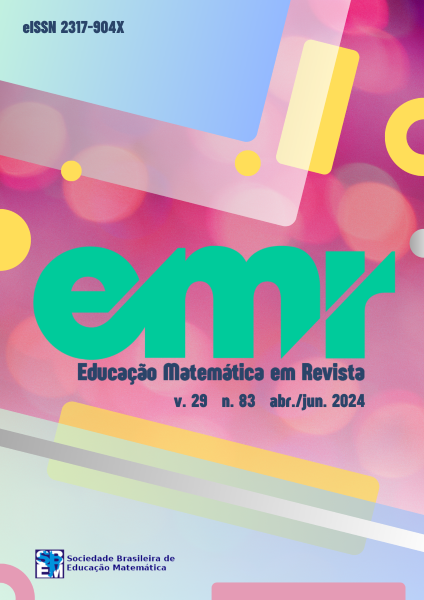Mathematical Modelling Activity about Buying Toys with 1st Year Elementary School Students
DOI:
https://doi.org/10.37001/emr.v29i83.3800Keywords:
Elementary School, Semiotic resources, Monetary system, Rounding, Data processingAbstract
This report aims to highlight the semiotic resources that students in the 1st year of Elementary School chose to develop a mathematical modelling activity. Mathematical Modelling is approached as a pedagogical alternative for teaching mathematics that allows the use of different signs to encompass mathematical objects. The means chosen and used in the production of signs are called semiotic resources. The availability of semiotic resources by the teacher to develop the activity with the theme of buying toys, allowed 25 students from a municipal school in Paraná to produce written, spoken and gestured signs that supported the construction of mathematical models for organizing banknotes. fictitious money to solve the modelling problem. Semiotic resources allowed students to articulate signs associated with the phenomenon under study and the mathematical objects that emerged from it, implying a solution to the problem via mathematical language.
Downloads
References
ALMEIDA, L. M. W.; SILVA, K. A. P. A Ação dos Signos e o Conhecimento dos Alunos em Atividades de Modelagem Matemática. Bolema, Rio Claro (SP), v. 31, n. 57, p. 202 - 219, abr. 2017.
ALMEIDA; L. W.; SILVA; K. P.; VERTUAN, R. E. Modelagem Matemática na Educação Básica. São Paulo: Contexto, 2012.
ARAKI, P. H. H. Atividades experimentais investigativas em contexto de aulas com Modelagem Matemática: uma análise semiótica. 2020. 178f. Dissertação (Mestrado em Ensino de Matemática) – Universidade Tecnológica Federal do Paraná.
BURAK, D. Modelagem Matemática nos diferentes níveis de ensino: uma perspectiva. In: ENCONTRO PARANAENSE DE MODELAGEM EM EDUCAÇÃO MATEMÁTICA, 12, 2014. Anais... Campo Mourão, 2014.
ENGLISH, L. D.; WATTERS, J. J. Mathematical Modelling with young children. In: HØINES, J.; FUGLESTAD, A. B. (Eds.). The 28th Conference of the International Group for the Psychology of Mathematics Education. Bergen, pp. 335–342, 2004.
MAVERS, D. E. Multimodal design: the semiotic resources of children’s graphic representation. 2004. 243 f. Thesis (Doutorado) – Institute of Education, University of London, London. 2004.
PESSOA, T. C.; SILVA, K. A. P. Recursos Semióticos em uma Atividade de Modelagem Matemática Integrada à Educação STEAM. Perspectivas da Educação Matemática, v. 16, n. 43, p. 1-21, 2023.
SILVA, K. A. P.; ARAKI, P. H. H.; BORSSOI, A. H. Tecnologias como recurso semiótico no desenvolvimento de atividades de Modelagem Matemática. Revista Brasileira de Educação em Ciências e Educação Matemática, v. 2, p. 362-386, 2018.
SILVA, K. A. P.; PELAQUIM, S. C. P. Estratégias de alunos dos anos iniciais do Ensino Fundamental na abordagem de problemas de modelagem matemática. Educação Matemática em Revista, n. 79, p. 01-16, junho, 2023.
TORTOLA, E. Configurações de Modelagem Matemática nos anos iniciais do Ensino Fundamental. 2016. 304f. Tese (Doutorado em Ensino de Ciências e Educação Matemática) – Universidade Estadual de Londrina, Londrina, 2016.
TUZZO, S.; BRAGA, C. O processo de triangulação da pesquisa qualitativa: o metafenômeno como gênese. Revista Pesquisa Qualitativa, v. 4, n. 5, p. 140-158, ago. 2016.
YOON, C.; MISKELL, T. Visualising cubic reasoning with semiotic resources and modeling cycles. In: SÁENZ-LUDLOW, A.; KADUNZ, G. (eds.). Semiotics as a tool for learning mathematics: How to describe the construction, visualisation, and communication of mathematical concepts. (p. 89-109). Dordrecht, The Netherlands: Sense Publishers, 2016.
Published
How to Cite
Issue
Section

This work is licensed under a Creative Commons Attribution-NonCommercial-ShareAlike 4.0 International License.






